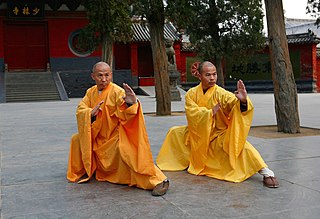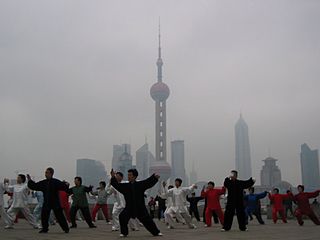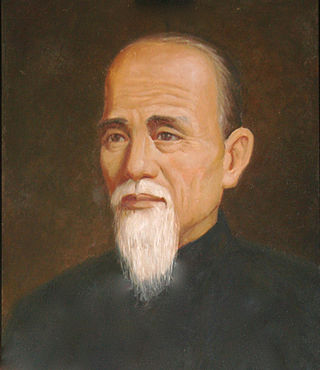
Drunken Master, also known as Drunken Master The Beginning, is a 1978 Hong Kong martial arts comedy film directed by Yuen Woo-ping and produced and co-written by Ng See-yuen. The film features much of the same crew as Yuen's Snake in the Eagle's Shadow released earlier the same year, including lead actors Jackie Chan, Yuen Siu-tien, and Hwang Jang-lee; although narratively unrelated, Drunken Master bears similarities to its predecessor in its story and style.

Chinese martial arts, commonly referred to with umbrella terms kung fu, kuoshu or wushu, are multiple fighting styles that have developed over the centuries in Greater China. These fighting styles are often classified according to common traits, identified as "families" of martial arts. Examples of such traits include Shaolinquan (少林拳) physical exercises involving All Other Animals (五形) mimicry or training methods inspired by Old Chinese philosophies, religions and legends. Styles that focus on qi manipulation are called internal, while others that concentrate on improving muscle and cardiovascular fitness are called external. Geographical associations, as in northern and southern, is another popular classification method.
The following outline is provided as an overview of and topical guide to martial arts:

Snake in the Eagle's Shadow is a 1978 Hong Kong martial arts action comedy film directed by Yuen Woo-ping in his directorial debut. It stars Jackie Chan, Hwang Jang-lee, and Yuen Woo-ping's real life father, Yuen Siu-tien. The film's plot is about Chien Fu, an orphan who is bullied at a kung fu school, meeting an old beggar, Pai Cheng-tien, who becomes his sifu (teacher) and trains him in Snake Kung Fu.
Hong Kong action cinema is the principal source of the Hong Kong film industry's global fame. Action films from Hong Kong have roots in Chinese and Hong Kong cultures including Chinese opera, storytelling and aesthetic traditions, which Hong Kong filmmakers combined with elements from Hollywood and Japanese cinema along with new action choreography and filmmaking techniques, to create a culturally distinctive form that went on to have wide transcultural appeal. In turn, Hollywood action films have been heavily influenced by Hong Kong genre conventions, from the 1970s onwards.

Chiu Chi-ling is a martial artist and actor who appears mostly in Kung Fu style movies produced in Hong Kong. He also teaches Hung Gar Kung Fu at Chiu Chi-ling Hung Gar Kung Fu Association, a San Francisco-based martial arts school he founded, and at the old Chiu Family Kwoon in Hong Kong rooted under the lineage of Lam Sai-wing. Every year he visits his students and grand students around the world and organizes worldwide Kung Fu tournaments. The Kung Fu style he is part of was passed down directly from southern shaolin temple and carries names like Hung Hei-gun and Wong Fei-hung.
Tiger & Crane Fists is a 1976 kung fu movie, starring and directed by 70s Hong Kong star Jimmy Wang Yu.
Kung fu film is a subgenre of martial arts films and Hong Kong action cinema set in the contemporary period and featuring realistic martial arts. It lacks the fantasy elements seen in wuxia, a related martial arts genre that uses historical settings based on ancient China. Swordplay is also less common in kung-fu films than in wuxia and fighting is done through unarmed combat.

There are hundreds of different styles of Chinese martial arts, each with their own sets of techniques and ideas. The various movements in kung fu, most of which are imitations of the fighting styles of animals, are initiated from one to five basic foot positions: normal upright posture and the four stances called dragon, frog, horse riding, and snake.

The Li family of kung fu is one of the five family styles of Southern Chinese martial arts.

Fut Ga Kuen or Buddhist Family Fist is a relatively modern Southern Shaolin style of Kung Fu devised primarily from the combination of Hung Ga Kuen 洪家 and Choy Gar 蔡家 Kuen. The style utilizes mostly punches, palm strikes and low kicks, further characterized by evasive footwork, circular blocks and using the opponent's force against them.

Choy Gar, also Caijia Quan, is a Chinese martial art deriving its name from the Cantonese-born founder, Choy Gau Lee (蔡九儀), and is one of the five main family styles of Kung Fu in Southern China. It was taught to him by a monk named Yi Guan. This style, founded in the 17th century, is a combination of rat and snake styles emphasizing on swift footwork and rapid strikes.

Choy Lee Fut is a Chinese martial art and wushu style, founded in 1836 by Chan Heung (陳享). Choy Li Fut was named to honor the Buddhist monk Choy Fook who taught him Choy Gar, and Li Yau-san (李友山) who taught him Li Gar, plus his uncle Chan Yuen-wu (陳遠護), who taught him Hung Kuen, and developed to honor the Buddha and the Shaolin roots of the system.

Chan Heung was the founder of the Choy Li Fut martial arts system.

Cheung Ah-yim ; b. 1824–d. 1893) a.k.a.Jeung Yim, Cheung Yim, Cheung Hung-sing, Jeong Hung-sing, Jeong Hong-sing, Zhang Yan, Zhang Hongsheng; is recognized as an important contributor (co-founder) to the expansion of Choy Lee Fut - a Southern Chinese martial arts system, and was the most famous of Chan Heung's disciple to emerge from the Choy Lee Fut System.

Doc-Fai Wong is a master of tai chi and the Hung Sing branch of Choy Li Fut kung fu. He was born in 1948 in the Guangdong province of China, specifically, the Wangshan village in the Doumen District of Zhuhai. In April 1960, he and his mother immigrated to San Francisco, California to be reunited with his father. He arrived as a third-generation citizen of the United States of America since both his grandfather and father were already citizens. He sought out his first kung fu teacher - Lau Bun (劉彬), the founder of the first Hung Sing Kwoon of Choy Li Fut in America, after encountering taunting and bullying due to language and ethnic difficulties after his arrival. When Lau Bun died in 1967, Wong Doc-Fai started teaching and opened his first school aged 19.
Taishanese people, Sze Yup people, or Toisanese are a Yue-speaking Han Chinese group coming from Sze Yup, which consisted of the four county-level cities of Taishan, Kaiping, Xinhui and Enping. Heshan has since been added to this historic region and the prefecture-level city of Jiangmen administers all five of these county-level cities, which are sometimes informally called Ng Yap. The ancestors of Taishanese people are said to have arrived from central China under a thousand years ago and migrated into Guangdong during the Tang Dynasty. Taishanese, as a dialect of Yue Chinese, has linguistically preserved many characteristics of Middle Chinese.

Snake kung fu is a Shaolin boxing style, one of several Chinese martial arts known as "snake boxing" or "fanged snake style" that imitate the movements of snakes. Proponents claim that adopting the fluidity of snakes allows them to entwine with their opponents in defense and strike them from angles they would not expect in offense. Snake style is said to especially lend itself to applications with the Chinese straight sword. The snake is also one of the animals imitated in Yang-style tai chi, Baguazhang and Xingyiquan. The sinuous, fluid motion of the snake lends itself to the practical theory that underlies the "soft" martial arts.
Chan Kowk-wai was born on 3 April 1936, in Taishan in the province of Guangdong, China. He introduced traditional Shaolin kung fu to Brazil through the China-Brazil Kung Fu Academy. His disciples have spread as far as the USA, Canada, Spain, Argentina and the Czech Republic.
Tibetan White Crane, also known in Cantonese as Bak Hok Pai, is a Chinese martial art with origins in 15th-century Tibetan culture that has developed deep roots in southern China. Tibetan White Crane became so established in Guangdong, Hong Kong and Macau by the twentieth century that it was accepted as a local martial art in that region. From there it has spread around the world.











